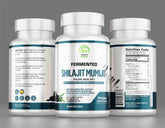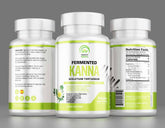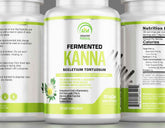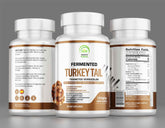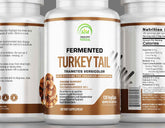Vitamin E as an Antioxidant
How Vitamin E Works as an Antioxidant: Benefits Explained
Vitamin E is a vital nutrient with powerful antioxidant properties that play a crucial role in protecting the body from oxidative stress and supporting overall health. This fat-soluble vitamin is composed of a group of eight compounds, including tocopherols and tocotrienols, each with distinct biological activities. As an antioxidant, vitamin E helps neutralize harmful free radicals, preventing cellular damage and contributing to the prevention of various diseases. This comprehensive blog explores the importance of vitamin E as an antioxidant, its physiological functions, sources, recommended dosages, potential side effects, and practical tips for incorporating this essential nutrient into your diet through dietary supplements.
Understanding Vitamin E
Vitamin E is a collective term for a group of eight structurally related compounds, which are divided into two categories:
- Tocopherols: Alpha (α), beta (β), gamma (γ), and delta (δ) tocopherols.
- Tocotrienols: Alpha (α), beta (β), gamma (γ), and delta (δ) tocotrienols.
Among these, alpha-tocopherol is the most biologically active form and is the predominant form found in human tissues and supplements.
Structure and Function
The structural differences between tocopherols and tocotrienols lie in the saturation of the side chain. Tocopherols have a saturated phytyl tail, while tocotrienols possess an unsaturated isoprenoid tail. These structural variations influence their antioxidant activities and distribution in the body.
Antioxidant Properties
Vitamin E's primary function is to act as an antioxidant, protecting cells from damage caused by free radicals. Free radicals are unstable molecules that can cause oxidative stress, leading to cellular damage and contributing to the development of chronic diseases such as cardiovascular disease, cancer, and neurodegenerative disorders.
The Role of Vitamin E as an Antioxidant
Neutralizing Free Radicals
Free radicals are highly reactive molecules with unpaired electrons. They can cause damage to lipids, proteins, and DNA, leading to cellular dysfunction and disease. Vitamin E neutralizes free radicals by donating an electron, stabilizing them, and preventing further damage.
Mechanisms of Action
- Lipid Peroxidation Prevention: Vitamin E is particularly effective at preventing lipid peroxidation, a process in which free radicals attack polyunsaturated fatty acids in cell membranes. This protective action maintains the integrity and function of cellular membranes.
- Chain-Breaking Antioxidant: As a chain-breaking antioxidant, vitamin E halts the propagation of free radical reactions by reacting with lipid peroxyl radicals, forming a stable, non-radical product.
Evidence from Clinical Studies
Numerous studies have demonstrated vitamin E's ability to neutralize free radicals and prevent oxidative damage. Research published in the Journal of Nutritional Biochemistry found that vitamin E supplementation reduced markers of oxidative stress in individuals with metabolic syndrome.
Protecting Cellular Membranes
Cellular membranes are composed of lipid bilayers that are susceptible to oxidative damage. Vitamin E, being lipid-soluble, is incorporated into the lipid bilayers of cell membranes, where it protects them from oxidative stress.
Mechanisms of Action
- Membrane Stability: By preventing lipid peroxidation, vitamin E maintains the stability and fluidity of cellular membranes, which is crucial for proper cell function.
- Protection of Polyunsaturated Fatty Acids: Vitamin E protects polyunsaturated fatty acids (PUFAs) in cell membranes from oxidative damage, preserving their function and preventing cell death.
Evidence from Clinical Studies
Research has shown that vitamin E supplementation enhances membrane stability. A study published in Free Radical Biology and Medicine demonstrated that vitamin E protects red blood cell membranes from oxidative damage, reducing hemolysis and improving cell viability.
Supporting Immune Function
Vitamin E plays a vital role in supporting the immune system by protecting immune cells from oxidative damage and enhancing their function.
Mechanisms of Action
- Protection of Immune Cells: Vitamin E protects lymphocytes and other immune cells from oxidative damage, ensuring their proper function and longevity.
- Enhancement of Immune Response: Vitamin E modulates immune responses by enhancing the production of antibodies and the activity of natural killer (NK) cells.
Evidence from Clinical Studies
Studies have demonstrated that vitamin E supplementation can enhance immune function. Research published in the American Journal of Clinical Nutrition found that vitamin E supplementation improved immune responses in elderly individuals, including increased production of antibodies and enhanced NK cell activity.
Cardiovascular Health
Vitamin E's antioxidant properties contribute to cardiovascular health by protecting low-density lipoprotein (LDL) cholesterol from oxidation, a key step in the development of atherosclerosis.
Mechanisms of Action
- Inhibition of LDL Oxidation: Vitamin E prevents the oxidation of LDL cholesterol, reducing the formation of oxidized LDL, which is a major contributor to the development of atherosclerotic plaques.
- Reduction of Inflammation: By preventing oxidative damage, vitamin E reduces inflammation, a key factor in the progression of cardiovascular diseases.
Evidence from Clinical Studies
Numerous studies have explored the role of vitamin E in cardiovascular health. A study published in Arteriosclerosis, Thrombosis, and Vascular Biology found that vitamin E supplementation reduced the oxidation of LDL cholesterol and markers of inflammation in individuals at risk for cardiovascular disease.
Neuroprotection
Vitamin E's antioxidant properties extend to neuroprotection, where it helps protect the brain from oxidative stress, a major factor in neurodegenerative diseases such as Alzheimer's and Parkinson's diseases.
Mechanisms of Action
- Protection of Neuronal Cells: Vitamin E protects neurons from oxidative damage, reducing the risk of cell death and neurodegeneration.
- Reduction of Inflammatory Responses: Vitamin E modulates inflammatory responses in the brain, reducing neuroinflammation and protecting against cognitive decline.
Evidence from Clinical Studies
Research has shown that vitamin E may have neuroprotective effects. A study published in The Journal of the American Medical Association found that vitamin E supplementation slowed the progression of Alzheimer's disease in patients with mild to moderate symptoms.
Skin Health
Vitamin E is widely recognized for its benefits to skin health, providing protection against oxidative damage caused by environmental factors such as UV radiation and pollution.
Mechanisms of Action
- UV Protection: Vitamin E absorbs UV light and helps prevent UV-induced free radical damage to skin cells.
- Anti-Inflammatory Effects: Vitamin E reduces skin inflammation caused by oxidative stress, promoting skin healing and reducing the risk of skin disorders.
Evidence from Clinical Studies
Studies have highlighted the benefits of vitamin E for skin health. Research published in The Journal of Investigative Dermatology found that topical application of vitamin E reduced UV-induced skin damage and inflammation.
Eye Health
Vitamin E plays a crucial role in protecting the eyes from oxidative damage, which can contribute to the development of cataracts and age-related macular degeneration (AMD).
Mechanisms of Action
- Protection of Ocular Tissues: Vitamin E protects the lens and retina from oxidative damage, maintaining eye health and preventing vision loss.
- Reduction of Oxidative Stress: By neutralizing free radicals, vitamin E reduces oxidative stress in the eyes, which is a major factor in the development of cataracts and AMD.
Evidence from Clinical Studies
Research has shown that vitamin E supplementation can support eye health. A study published in Ophthalmology found that vitamin E, in combination with other antioxidants, reduced the risk of developing advanced AMD in individuals with high-risk factors.
Sources of Vitamin E
Ensuring adequate vitamin E intake is essential for maintaining its antioxidant benefits. There are several sources of vitamin E, including dietary sources and supplements.
Dietary Sources
Vitamin E is found in a variety of foods, particularly those rich in healthy fats. Some excellent dietary sources include:
- Nuts and Seeds: Almonds, sunflower seeds, hazelnuts, and peanuts are rich sources of vitamin E.
- Vegetable Oils: Wheat germ oil, sunflower oil, safflower oil, and olive oil contain high levels of vitamin E.
- Green Leafy Vegetables: Spinach, kale, and Swiss chard are good sources of vitamin E.
- Fortified Foods: Some breakfast cereals and fruit juices are fortified with vitamin E to enhance their nutritional value.
Supplements
Vitamin E supplements are available in various forms, including natural and synthetic versions. The natural form, denoted as d-alpha-tocopherol, is more bioavailable than the synthetic form, dl-alpha-tocopherol.
Types of Supplements
- Alpha-Tocopherol: The most common form found in supplements, available as d-alpha-tocopherol (natural) or dl-alpha-tocopherol (synthetic).
- Mixed Tocopherols: Supplements containing a blend of tocopherols (alpha, beta, gamma, and delta) provide a broader range of antioxidant protection.
- Tocotrienols: Available as supplements, tocotrienols have unique antioxidant properties and may offer additional health benefits.
Dosage Recommendations
The recommended dietary allowance (RDA) for vitamin E varies based on age, sex, and life stage:
- Infants (0-6 months): 4 mg (6 IU) per day
- Infants (7-12 months): 5 mg (7.5 IU) per day
- Children (1-3 years): 6 mg (9 IU) per day
- Children (4-8 years): 7 mg (10.5 IU) per day
- Children (9-13 years): 11 mg (16.5 IU) per day
- Teenagers (14-18 years): 15 mg (22.5 IU) per day
- Adults (19 years and older): 15 mg (22.5 IU) per day
- Pregnant Women: 15 mg (22.5 IU) per day
- Lactating Women: 19 mg (28.5 IU) per day
Considerations for Supplement Use
- Individual Needs: Dosage may vary based on specific health conditions, lifestyle, and dietary intake.
- Supplement Form: Choose a supplement form that best suits your needs, such as natural d-alpha-tocopherol or mixed tocopherols.
- Consultation with a Healthcare Provider: It is essential to consult with a healthcare provider to determine the appropriate dosage for your specific needs and to avoid potential toxicity.
Potential Side Effects and Considerations
Common Side Effects
Vitamin E is generally safe for most people when taken within the recommended dosages. However, excessive intake can lead to certain side effects, including:
- Gastrointestinal Issues: High doses of vitamin E can cause nausea, diarrhea, and stomach cramps.
- Fatigue and Weakness: Some individuals may experience fatigue and muscle weakness with high doses of vitamin E.
Rare Side Effects
In rare cases, very high doses of vitamin E can lead to more serious health issues, including:
- Increased Bleeding Risk: High doses of vitamin E can interfere with blood clotting, increasing the risk of bleeding, particularly in individuals taking anticoagulant medications.
- Hemorrhagic Stroke: Excessive vitamin E intake has been associated with an increased risk of hemorrhagic stroke.
Recommendations for Safe Use
To ensure safe and effective use of vitamin E supplements, consider the following recommendations:
- Consult with a Healthcare Provider: Before starting vitamin E supplements, consult with a healthcare provider, particularly if you have underlying health conditions or are taking medications.
- Choose High-Quality Supplements: Select vitamin E supplements from reputable brands that provide third-party testing and certification to ensure purity and potency.
- Follow Recommended Dosages: Adhere to recommended dosages and avoid taking more than the advised amount unless under medical supervision.
Lack of Vitamin E Symptoms
- Common Symptoms of Vitamin E Deficiency:
- Muscle Weakness: Due to oxidative damage to muscle tissue and nerves.
- Impaired Coordination (Ataxia): Damage to the nervous system may affect balance and coordination.
- Numbness and Tingling: Especially in the hands and feet, caused by nerve damage (peripheral neuropathy).
- Vision Problems: Retinal degeneration can occur in severe cases.
- Immune System Issues: Lower resistance to infections due to impaired immune response.
- Who Is at Risk?
- Fat absorption disorders (e.g., Crohn’s disease, cystic fibrosis)
- Genetic conditions affecting vitamin E transport
- Very low-fat diets over an extended period
A lack of vitamin E in the body, while relatively rare, can lead to a range of noticeable symptoms, especially over time. This fat-soluble vitamin plays a critical role in protecting cells from oxidative damage and supporting immune and nervous system functions.
Vitamin E deficiency is more likely in individuals with:
Eating a balanced diet rich in nuts, seeds, vegetable oils, and leafy greens usually provides enough vitamin E. In some cases, supplementation may be recommended by healthcare professionals.
Practical Tips for Incorporating Vitamin E into Your Diet
Dietary Sources
Incorporating vitamin E-rich foods into your diet can help ensure adequate intake. Consider adding the following foods to your meals:
- Nuts and Seeds: Add almonds, sunflower seeds, or hazelnuts to your salads, yogurt, or oatmeal.
- Vegetable Oils: Use sunflower oil, safflower oil, or olive oil for cooking and salad dressings.
- Green Leafy Vegetables: Include spinach, kale, or Swiss chard in your salads, smoothies, or as side dishes.
- Fortified Foods: Choose fortified breakfast cereals and fruit juices to boost your vitamin E intake.
Supplements
When dietary intake is insufficient, vitamin E supplements can help ensure adequate levels. Consider the following tips:
- Choose the Right Form: Opt for natural d-alpha-tocopherol or mixed tocopherols for better bioavailability.
- Dosage: Follow the recommended dosages and consult with a healthcare provider to determine the appropriate amount for your needs.
- Consistency: Take your vitamin E supplement consistently at the same time each day to establish a routine and ensure regular intake.
Monitoring and Adjusting Intake
Regular monitoring of your vitamin E levels can help you adjust your intake as needed. Consider the following practices:
- Blood Tests: Periodic blood tests can help monitor your vitamin E levels and ensure they are within the optimal range.
- Consult with a Healthcare Provider: Regular consultations with a healthcare provider can help you adjust your vitamin E intake based on your health status and lifestyle.
Research and Future Directions
Ongoing Research
Research on vitamin E and its health benefits is ongoing, with numerous studies exploring its role in disease prevention, treatment, and overall well-being. Future research aims to better understand the optimal dosages, forms, and combinations of vitamin E for specific health conditions.
Personalized Nutrition
The field of personalized nutrition is emerging, where dietary recommendations, including vitamin E supplementation, are tailored to an individual’s genetic makeup, lifestyle, and health status. This approach holds promise for maximizing the health benefits of vitamin E.
Novel Delivery Systems
Innovative delivery systems, such as liposomal and nanoemulsion technologies, are being developed to enhance the bioavailability and effectiveness of vitamin E supplements. These advancements may improve the absorption and stability of vitamin E, making it more accessible and beneficial for health.
Conclusion
Vitamin E is a crucial nutrient with powerful antioxidant properties that play a vital role in protecting the body from oxidative stress and supporting overall health. Its benefits extend to protecting cellular membranes, supporting immune function, enhancing cardiovascular health, providing neuroprotection, and promoting skin and eye health.
To reap the maximum benefits of vitamin E, it is essential to choose high-quality supplements, follow recommended dosages, and incorporate them into a balanced diet rich in natural sources of vitamin E. By taking a proactive approach to your health, you can enhance your overall well-being and prevent deficiencies that may lead to serious health issues.
Remember to consult with a healthcare provider before starting any new supplement regimen, particularly if you have underlying health conditions or are taking medications. With the right approach and guidance, vitamin E supplements can be a powerful tool in your journey toward optimal health.
Vitamin K for Blood Clotting: A Comprehensive Guide
This comprehensive blog will delve into the importance of vitamin K for blood clotting, its physiological functions, sources, recommended dosages, potential side effects, and practical tips for incorporating this vital nutrient into your diet through dietary supplements..
- Choosing a selection results in a full page refresh.



